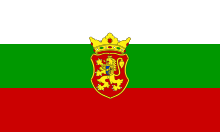Bulgarians in Serbia(Serbian:Бугари у Србији,romanized:Bugari u Srbiji;Bulgarian:Българи в Сърбия) are a recognizednational minorityinSerbia.According to the 2022 census, the population of ethnicBulgariansin Serbia is 12,918, constituting 0.2% of the total population. The vast majority of them live in the southeastern part of the country that bordersBulgariaandNorth Macedonia.
Бугари у Србији Bugari u Srbiji Българи в Сърбия | |
|---|---|
 Flag of the National Council of the Bulgarian minority in Serbia | |
| Total population | |
| 12,918Serbian citizens,0.19%of Serbia's population (2022)[1] | |
| Regions with significant populations | |
| 4,075 (67.19%)[2] | |
| 3,669 (45.62%)[2] | |
| Languages | |
| Bulgarian,Serbian | |
| Religion | |
| Bulgarian Orthodox,Serbian Orthodox | |
| Related ethnic groups | |
| South Slavs | |
History
editThe regional names once used by many people in the Torlakian-speaking region wasTorlaciandŠopispeaking a transitional speech between Bulgarian and Serbian. Before theOttomanconquest, the borders of the region frequently shifted betweenByzantine,BulgarianandSerbianrulers. According to some authors during the Ottoman rule, the majority of native Torlakian Slavic population did not have a distinct national consciousness in the ethnic sense.[3]The first known literary monument, influenced by Torlakian dialects is the Manuscript fromTemskaMonastery from 1762, in which its author, the MonkKiril ZhivkovichfromPirot,considered his language as: "simple Bulgarian".[4]
ASilesiantraveler stated in 1596 that the road of his trip from Sofia to Niš was filled with corpses and described the gates of Niš as standing in front of freshly beheaded heads of poor Bulgarian peasants by the Ottoman army.[5]ThePirot Rebellionbroke out in 1836, followed by theNiš rebellionin 1836, which also included Pirot. According to Ottoman statistics during theTanzimatthe greater part of the population up to theSanjak of Nišwas treated as Bulgarian.[6]According to all authors between 1840 and 1872 the delineation between Bulgarians and Serbs is undisputed and ran north of Niš.[7]The Serbian researchers (such asDimitrije Davidovićin 1828 andMilan Savićin 1878) also acceptedSouth Moravariver as such delineation and added Niš outside the borders of the Serbian people.[7][8]It was also stipulated the area to be ceded to Bulgaria according to theConstantinople Conferencein 1876 and most of it according to theTreaty of San Stefanoin 1878. From 1870 until then the area was part of theBulgarian Orthodox Church,before that the area had been under theEcumenical Patriarchate of Constantinopleand theSerbian Patriarchate of Peć.
FollowingWorld War I,four territories, now known to the Bulgarian community as theWestern Outlands,passed to theKingdom of Serbs, Croats and SlovenesfromBulgariaas a war indemnity, and the remains of the old border can be seen atVlasina lake.[citation needed]In the Interwar Period, theInternal Western Outland Revolutionary Organisation,countering Yugoslav rule in the region, was engaged in repeated attacks against the Yugoslav police and army. DuringWorld War IIBulgaria retook the Western Outlands, as well asPirotandVranje.After theSecond World War,these regions were returned to Yugoslavia. AfterSerbia's independence, these areas remained within Serbia.
Demographics
editAccording to the 2011 census, there were 18,543 Bulgarians in Serbia. They are primarily located in two municipalities near Serbia's border with Bulgaria: inBosilegradthere are 5,839 Bulgarians i.e. 71.9% of population while inDimitrovgrad(Tsaribrod) there are 5,413 Bulgarians or 53.5% of population.[9][10]
The dominant religion among ethnic Bulgarians in Serbia isOrthodoxy.Islamnever arrived in areas likeBosilegradbecause of the mountainous terrain and most inhabitants dwelled in high mountain villages where they were hard to reach. They use bothSerbianandBulgarianchurches due to the low number of Bulgarian clergymen present in the region. There is a church in every village aroundBosilegrad,and the oldest ones date to the 11th century.
| Year (census data) |
Number of ethnic Bulgarians | Number of Bulgarian speakers | Percent of national population |
|---|---|---|---|
| 1948 | 59,472 | 1.0% | |
| 1953 | 60,146 | 59,166 | 1.0% |
| 1961 | 58,494 | 0.9% | |
| 1971 | 53,800 | 49,942 | 0.7% |
| 1981 | 33,455 | 35,269 | 0.4% |
| 1991 | 26,698 | 25,408 | 0.3% |
| 2002 | 20,497 | 16,459 | 0.3% |
| 2011 | 18,543 | 13,337 | 0.3% |
| 2022 | 12,918 | 7,939 | 0.2% |
Notable people
edit- Helena of Bulgaria,regent of Serbia 1355–1356
- Gregory Tsamblak(c.1365–1420), medieval writer and cleric
- Vene Bogoslavov(1932–2015), mathematician
References
edit- ^"Final results - Ethnicity".Почетна.2023-07-14.Retrieved2023-12-07.
- ^ab"Population by ethnicity, by areas"(PDF).Retrieved2023-12-07.
- ^Roudometof, Victor; Robertson, Roland (2001). Nationalism, globalization, and orthodoxy: the social origins of ethnic conflict in the Balkans. Greenwood Publishing Group. pp. 68-71.ISBN0313319499.
- ^Василев, В.П. Темският ръкопис – български езиков паметник от 1764 г, Paleobulgarica, IX (1986), кн. 1, с. 49-72
- ^Kultur der Nationen(in German). p. 110.
- ^Ottoman Bulgaria in the First Tanzimat Period — The Revolts in Nish (1841) and Vidin (1850) Mark Pinson, Middle Eastern Studies, Vol. 11, No 2 (May, 1975), pp. 103-146.
- ^abLight, Andrew; Smith, Jonathan M. (1998).Philosophy and Geography II: The Production of Public Space.Rowman & Littlefield. pp. 240, 241.ISBN9780847688104.
- ^Savić, Milan (1981)."Istorii︠a︡ na bŭlgarskii︠a︡ narod".google.bg.
- ^"Ethno-confessional and language mosaic of Serbia"(PDF).Statistical Office of the Republic of Serbia. 2014.
- ^http:// isac-fund.org/download/sr-bg-BUG.pdf.
{{cite web}}:Missing or empty|title=(help)